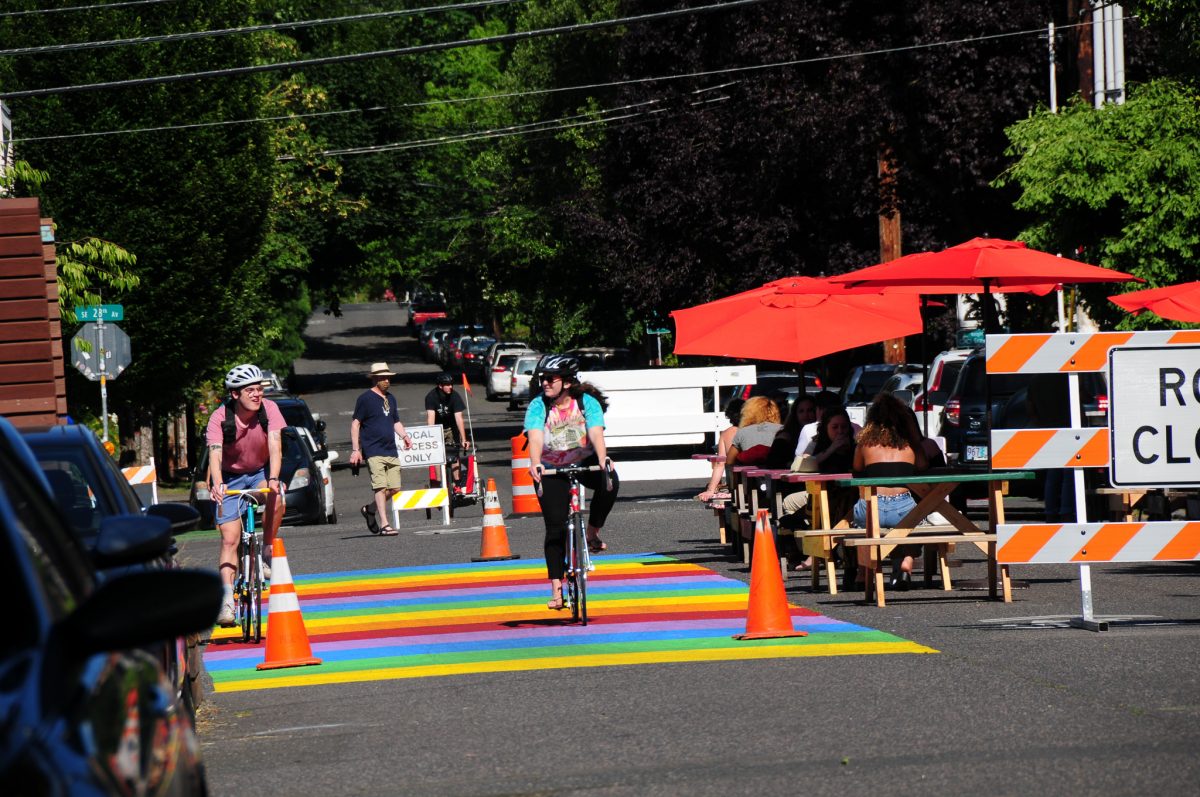
For better or for worse, there are a lot of things from the COVID-19 pandemic that are now relics of a bygone era. One good thing from the pandemic that’s here to stay? Outdoor dining. Through the Portland Bureau of Transportation’s Healthy Businesses Permit Program, those street seating installations that emerged as a way to enable social distancing during the pandemic will now become a permanent fixture of Portland’s street life.
But it’s not just going to be as simple as putting a table on the sidewalk and calling it a day. PBOT is currently developing a set of design guidelines (PDF) for outdoor dining to figure out how they’re going to run this program going forward, and they’re asking for community input with a new survey.
All Portlanders — whether you’re a customer, neighbor or business owner who is considering sidewalk café seating — are encouraged to fill out this survey, which asks questions about the program generally, proposed design standards, accessibility and more.
One of the design changes PBOT is proposing is to prohibit structures over sidewalks. Right now, the Healthy Business Permit mandates that at least six feet of sidewalk space be available for passage, but businesses have created outdoor seating areas using tents or structures partially set up on the sidewalk (see image on the right for an example).
PBOT is also proposing that a new ADA accessibility requirement that would mandate all new street seating installations in the parking lane with a year-long permit must be accessible for people in wheelchairs, achieved by creating sidewalk-level platforms or installing a ramp to an elevated dining platform.
The draft plan also proposes the following site operations guidelines:
- Maintenance plan requirement: Permit holders must plan for site maintenance and graffiti removal.
- No smoking in enclosed spaces: Per the Oregon Indoor Clean Air Act, no smoking is allowed in street seating installations with a roof and side wall enclosure.
- Good Neighbor Agreement requirements: A good neighbor agreement may be required to respond to complaints from neighboring businesses and residents. This may address hours of operation, noise, smoking or other issues.
- Amplified noise restrictions: No amplified noise allowed within street seating installations. Request a variance from the Portland Noise Office.
- No storage: No after-hours garbage and propane storage allowed within street seating installations.
We can’t imagine Portland without the outdoor dining areas that cropped up during the pandemic. The ‘Rainbow Road’ plaza on SE Ankeny is where we host our weekly Bike Happy Hour (Wednesdays, 3-6 pm) — we love all the outdoor seating in that plaza, and think more businesses should embrace the power of the outdoor cafe.
PBOT expects to bring a final proposal for their program guidelines to City Council for formal adoption in late May, and businesses would be expected to bring their sites into compliance with the final rules by the time the new permit cycle applications open in October. You can find more information about the Healthy Business Permit program here, and find the survey here.



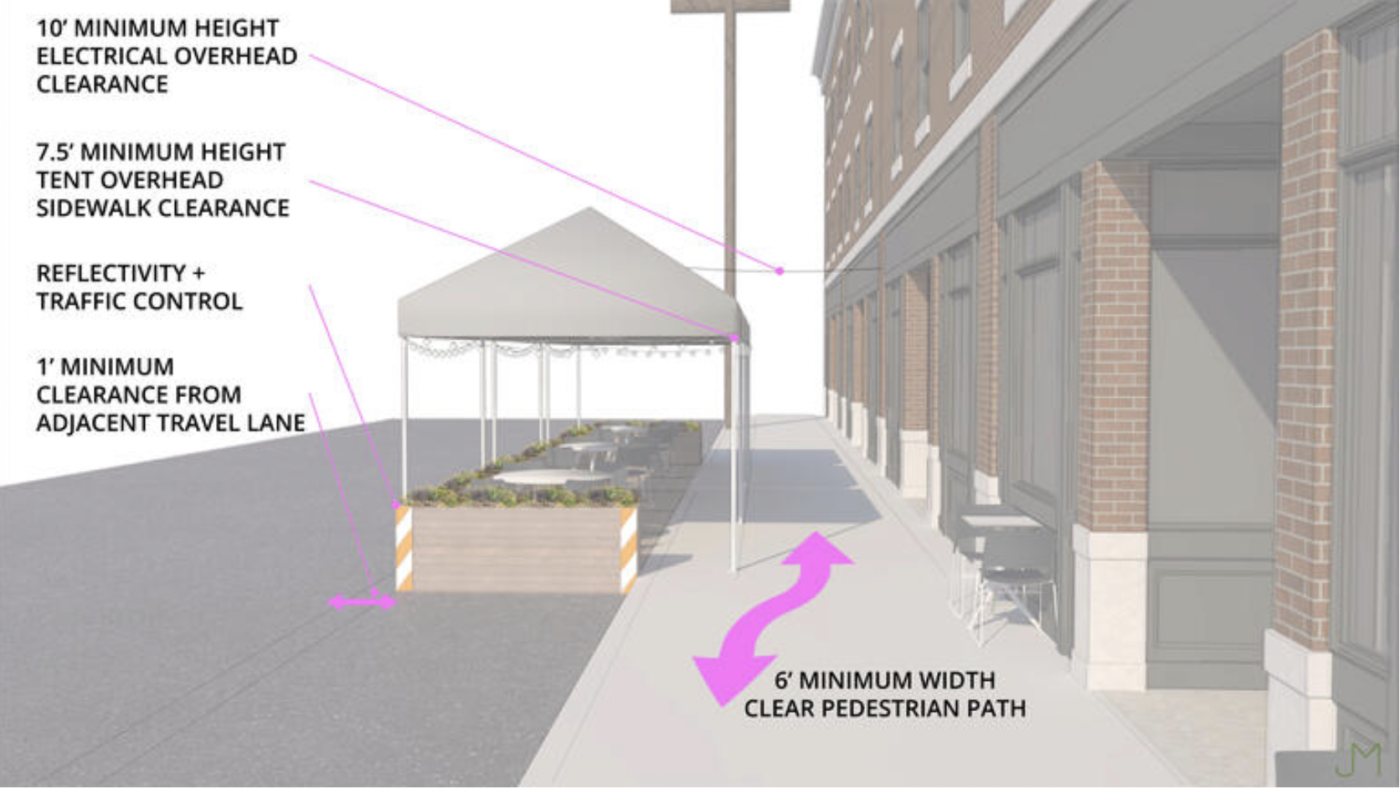
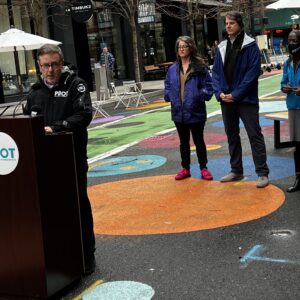
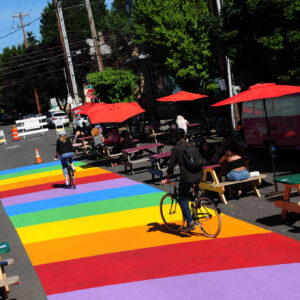
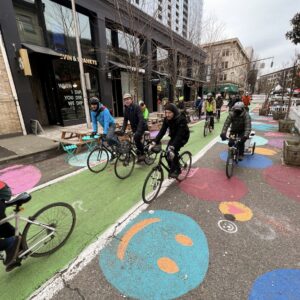

Thanks for reading.
BikePortland has served this community with independent community journalism since 2005. We rely on subscriptions from readers like you to survive. Your financial support is vital in keeping this valuable resource alive and well.
Please subscribe today to strengthen and expand our work.
They are a very nice addition to the city as long as there is some kind of architectural review (which can be controversial).
The Sidewalks must be kept open and can be. Some restaurants are building nice permanent heated enclosures using the parking spaces and allowing people to walk through the restaurant which is great.
Old worn out picnic tables with falling down visqueen plastic covers and half blocking the sidewalk is the problem.
They are a pleasant traffic obstruction but in a lot of cases cycling, you have to take the lane.
The bike lanes and space on the right side is taken by the restaurants which in a lot of cases means sharing the space with cars which a lot people riding here are against.
28th east is a prime example.
I’m just so worried some crazy driver is going to take out a whole dining shack on the busier streets. The ones on the west side of NE 28th (near the cool Art Deco Coca Cola bottling plant) really freak me out.
It’s bound to happen but pulling over drunk erratic drivers by police before they do this is too far to go. We need to accept some carnage.
That’s some dark sarcasm dwk. We have no traffic offficers. “Just accept some carnage” seems to be the new Portland motto. 🙁
I love eating outside. However seeing all the ugly plywood COVID boxes covered in grafitti just reminds of the bad days of the pandemic and doesn’t exactly make me want to eat there (some are nice but lots need to go away–especially the ones on busy streets).
In the article and the linked proposal, graffiti cleanup among other things is the responsibility of the owner.
Yeah but if they’re not cleaning the graffiti now (and the Portland ordinance for removing within 10 days is NOT enforced) what makes you think it’ will happen with the new proposal?
https://www.portland.gov/code/14/b80
The rainbow road art is cool but the crowded space for people biking is really annoying.
For others who want a route that avoids this crowded mess (e.g. in the summer):
Southbound: turn left off ankeney at 24th, cross burnside, and continue on couch
Northbound: turn left off couch at 24th, cross burnside, and continue on ankeney
I agree. SE Ankeny was my bike commute route to and from downtown for many years. I was extremely annoyed when they had those concrete planters right in the middle of the narrow chute between the seating areas on both sides of the street. It forced me to ride closer than I would have liked to crowded tables where folks might have dogs or young children with them. Of course, I rode slowly and carefully through there, but I would have preferred to have more room for the safety of myself and the people using the new plaza.
Outdoor dining should not make our few established bike routes less safe or less convenient.
Slowing down, paying attention and gently rolling through to allow this amazing plaza-like experience and beautiful community is worth it 1000%! I agree with the recommendation that if you can’t be bothered to slow down, follow the alternate routes described.
Zaphod,
I disagree with you. It seems unreasonable to impede a bike route when we have so few bike routes. There are thousands of parking spaces for cars and hundreds of miles of streets- Remove space from drivers to create space for hanging out but please don’t reduce more bike spaces.
Southbound –>Eastbound
Nothbound –> Westbound
We need as much as possible and the cost should be as low as possible.
Basic standards and maintenance notwithstanding.
The prohibition of propane heaters on installation with roofs seems ridiculous to me. I would prefer to not use fossil fuels, and businesses will still have the option to use electric heaters, but it seems overly restrictive to me in a city that is often cold and wet. I have seen plenty of patios with propane heaters who have obviously figured out how to design their roofs so as not to burn down.
Second thing I noted: 50 ft setbacks from stop signs for patios with roofs is also extremely restrictive. Portland’s 200 ft blocks means that 50% of the street will no longer be allowed to have roofs (assuming 4 way stops – which we should want more of)! And of course, street corners are the most common place for restaurants to locate, so many restaurants would now no longer be able to protect their patrons from the rain.
The setback addresses the biggest issue I have with the current situation – visibility at intersections. Vehicles over 6ft tall aren’t allowed to park within 50ft of an intersection for the same reason. Some of the roofed installs are very hard to see around, especially if they have windows that aren’t completely transparent or are fogged with moisture.
I’m just returned from a trip to Santa Barbara and the massive bike and pedestrian only zone is amazing. Shops have foot traffic. I saw folks walking, biking, jogging at all hours. It just works – shutdown vehicle traffic and watch the community thrive.
Yeah but the weather and respect for enforcement of laws and ordinances is much different in Santa Barbara. We don’t even investigate hit and run injury accidents in PDX.
I would rather not have outdoor dining if it means losing bike lanes. My safety is more important to me.
I would rather people be employed and making a living….
It’s not difficult to ride around them.
Do you want to live in a society where bike mode share is less than 2.8%? If yes, then I guess you would support turning a major bike transportation route into a drinking area where businesses are allowed to place obstructions in a narrow cycling right of way.
The obstructions are mainly in parking spaces so I don’t care and they also obstruct cars also which is another reason I don’t care.
Restaurants employ the people I would assume you usually support. This city is sorely lacking any working class jobs that will allow non college degree people to reside here.
Not everyone is a WFH software developer or health care analyst….
I celebrate every lost parking space but restaurant furniture and restaurant-installed barriers have encroached on space for people cycling on what was once a heavily-used bikeway.
No WFH software developer’s happy hour is worth this:
Restaurants need the space to make any kind of profit these days so they can hire cooks, dishwashers, waiters, etc.
You did not address that need at all.
Deriding the use of pavement for non car purposes is important to YOU?
I guess “those” people can move and get jobs elsewhere and then you will have the street all to yourself because that’s what’s important.
How dare those waiters and waitresses, all those wealthy people get in your way trying to pay the rent….
Leaving 12 feet of unobstructed space for people on bikes does not harm working class people. There is plenty of room for people on bikes and for dive bar/brew pub seating on NE Ankeney.
Outdoor dining has been fantastic addition to the city. I love riding my bike by these on a sunny day and seeing people enjoying themselves in public (who otherwise would be concealed indoors). It’s great to have this extension of small businesses into public space, as these spaces should be connected instead of separate. It’s a win for vibrancy, place-building, and public safety.
The Clinton Greenway is part of my bike commute and I’ve had probably close to a dozen close calls running the entertainment gauntlet that the city created. Same for Ankeny. Drinkers / diners, pets, even waitstaff. Is it a transportation corridor or a food court? It’s nice that we made these things happen when “nobody” (note the quotes) was commuting to work, but now this just feels like another reason that mode share is going to remain permanently low.
It’s also rather hypocritical to criticize a business for demanding adjacent street parking only to turn around and praise them for claiming that very same space for seating. Between this and the normalization of street camping, how much public property & facilities have we lost to private use in the last few years?
I agree completely. I have already lost access by certain routes to my house by street seating at Se Flanders and Se 28th. No access to the east anymore here, limited access to the west as well. Where is the fire permits for the extra seating the restaurants now have. Some have doubled or tripled their dinning capacity with very little regard to safety. I find it appalling that this is going on all over the city. We have streets and sidewalks for a purpose and that purpose is not to have restaurants take them over. It’s ok to me to have a few areas designated for this purpose but it has gotten out of hand.
I replied to the survey and along with many of you, noted my concerns about the potential impacts on bike travel. Interestingly, there were no questions at all about how you thought the street seats impacted car, bike, bus travel and/or parking, so I guess PBOT is entirely unconcerned about those impacts. (Note: I’m not worried about any loss of car travel lanes or on-street parking myself, but I can see other respondents wanting to prioritize those things.) Asking people whether they want the installations set back 50 ft or 10 ft from intersections, or whether propane heaters can be stored outside, seems like focusing on the trees at the expense of the forest. Perhaps there was an earlier survey about how to best allocate the City’s valuable ROW???
I generally like the street seats and outdoor dining. I do not think it should reduce space for people biking and walking, though. I also hope they enforce the setbacks and heights.
I saw a presentation where someone from PBOT had spent A LOT of time and budget to help get the food carts established south of Burnside on the Park blocks. This was intended to support the businesses displaced from 10th/Alder. The second half of his presentation included a program they were working on to retrofit containers to be placed in the ROW to be used as retail spaces. I think PBOT is getting pretty far outside their lane with this. We have a lot of vacant space in buildings- it seems counterproductive to subsidize streetside shacks.
The ROW can be put to uses far batter than driving/storing cars, but think it is a slippery slope to start converting too much of it to private business. Lets keep our rights of way free, public and accessible. Limit driving and parking, but support walking, biking, sitting, hanging out.
15 minute neighborhoods are so last year aren’t they?
15 minute neighborhoods would be great. Lets get businesses into the storefronts. I would prefer the invest in helping businesses move into storefronts over the City paying for carts or retail huts on the street. I fully support 15 minute neighborhoods, and street seats, and sustainable business practices, and supporting small businesses and start-ups, and complete street. The current street seat program is mostly great, as our most of the food carts, but I don’t think that needs to be the only way the City supports doing business, and I do not think they are so wonderful that they should be accepted wherever and at whatever quality. The Rainbow street is nice and fun, but they did not do a good job of resolving the conflict with the bike route. I am not advocating removing that, but I am advocating that we acknowledge that and learn from it. Maybe the City should try to improve on it to claim more space for bikes ad give customers/employees and more intuitive way to recognize the right of way. Maybe the rainbow plaza should be shifted to 28th. Imagine if the parking and i lane of travel was removed for a block. The west 3/4 of the block could become a plaza, and the vehicle travel would be alternating one-way (like do for construction zones). Or the plaza could be raised to sidewalk level and leave a 12′ wide bike-only lane.